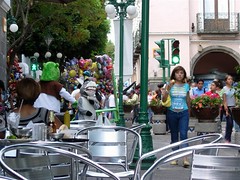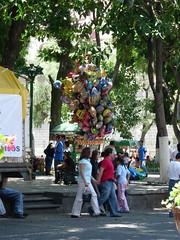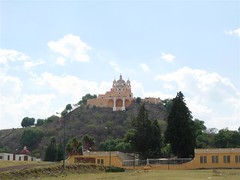My new t-shirt
Brian bought this for me at Wal-Mart-owned Suburbia, here in Mexico City.

Professor of Political Science & Sen. Wm. McMaster Chair in Gender & Methodology, McMaster University
Follow-up to yesterday’s social security story
Yesterday, the SNTSS submitted its complaint at the Mexico OIT offices yesterday. They are planning a march for July 21.
Social security conflict update
Last week (or maybe the week before), I met with a SNTSS (social security) union leader who mentioned he had just come back from Switzerland, where they had filed a complaint against the Mexican government in their on-going dispute over a August 2004 reform law to their pensions. The story has just been covered by the Mexican media, so I feel it is safe to comment. For an academic discussion of the context of the conflict, I have just finished a paper that is under review for publication.
Essentially, in the October 2003 labor contract negotiations, unionized IMSS workers failed to approve a reform to their pension scheme. (Many IMSS workers retire earning more than 100% of their last salary at only 55 years old.) In response, the administration of IMSS (with the support of employers organizations and corporatist or official unions) sought a reform law that had three effects:
1. Any new hires have to be approved by the tri-partite governing board of the IMSS.
2. Any new IMSS workers would be covered by the pension scheme of all private sector workers, not that of the current labor contract.
3. Contributions of workers covered by IMSS cannot be used to fund benefits for IMSS workers.
In response, the IMSS union filed a court case claiming that their pensions were a matter for their labor contract not law. The case has been passed around the courts, but soon it is expected that the courts will rule against the union. This will potentially open the way for similiar legislation to reduce by law the benefits negotiated in labor contracts by other powerful national industry unions, like Pemex, Luz y Fuerza del Centro, and the CFE.
Given the likelihood that the domestic courts will rule against the union, the union filed a complaint against the government with the OIT. In particular, the complaint points to the failure of the IMSS administration to replace retired and other workers who have left the IMSS since 2004. The IMSS administration has frozen hiring until the court case is resolved because they do not want to hire new workers under the old labor contract with high retirement benefits. The union is protesting this policy.
All of this conflict is likely to become more severe as the union and IMSS begin to renegotiate the labor contract again this fall.
Mexican Supreme Court to consider “day after pill”
Though the Secretary of Health approved and issued instructions for the use of the day after pill as a means of contraception, a pro-life group went to the courts for an injunction (or something legally similar). According to the article, the group actually targeted all forms of birth control, including condoms. The Supreme Court has decided to review the case and several judges want the case to pass to a full panel.
More on the EZLN, again
Today’s (leftist) paper has no less than nine articles about the EZLN.
First, the Secretary of State confirmed that the drugs destroyed last week were not in EZLN territory, and assures the public that the government is not beginning an offensive against the EZLN. The President’s office reiterated the same point. (See how nice the President and his Secretary of State can coordinate their statements and appear more consistent when neither is running for President? Creel’s contradictions of Fox’s spokesperson, I believe, did much to hurt people’s confidence in Fox and to some extent the PAN in general.)
On the other hand, the military does seem to be rearranging some of its personnel in the region, but to what ends is not clear.
Second, ONG’s are warning that paramilitary activity in Chiapas is on the rise, while at the same time, a government agency has decided that the EZLN is not a terrorist organization. The National Commission on Human Rights is urging the government and Zapatistas to begin a dialogue to avoid hostilities. The Bishop in Chiapas has said that the EZLN cannot remain silent on the 2006 elections.
In Puebla, several people protested in front of central Bancomer offices because the bank had cancelled eight accounts where national and international donors could send money for communities (including Zapatista communities) in Chiapas.
Third, a story about how deserted the rebel controlled parts of Chiapas appear. Reporters describe how some towns are like ghost towns; no one responds when reporters call out in the center of town. I’m not sure how much tourism was received by the rebel controlled (governed) areas before the red alert, but if any, it is certainly over now.
Fourth, sociologist Immanuel Wallerstein was in San Christobal in Chiapas to present his book yesterday, and La Jornada interviewed him about the situation.
My interpretation or opinion? The EZLN is clearly trying to move public opinion and affect the 2006 presidential elections. They have begun so early because the pre-candidates have begun their campaigns within each party and in public. So the EZLN would like to influence the candidacies and later the actual election. The down side to this early effort to have influence through the media is that it will probably bring additional hardship to many of the indigenous living in the EZLN controlled territories. It will probably also hurt tourism in the rest of Chiapas, as foreigners and nationals alike decide not to travel to Chiapas for fear of violence. (I should point out that if I had time, I would still plan a trip to Chiapas….not necessarily to rebel controlled areas…where I wouldn’t go even before the red alert…but a trip to the major cities and other areas should not be hurt. For instance, I would say that Chiapas is probably safer to visit even with the red alert, than nearly any border town right now.) So, the early mobilization will probably hurt the economy, which is unfortunate for the residents that live there.
Zapatista update (brief)
Three stories.
1. The government is removing onver 200 speed bumps from the rural highway in Zapatista controlled territory, to facilitate the movement of “emergency” vehicles.
2. Earlier this week or last week, it was reported that fields of marijuana had been destroyed by the federal government in Chiapas. Officials insist that the fields were in Zapatista controlled areas. Though the president’s office has said the fields were not in Zapatista territory.
3. The EU is aware of the recent escalation of EZLN activity.
Organized crime (and violence) update
More dead and escaped in Baja, Nuevo Laredo, and Michoacan.
Activist murdered in Queretaro
This week, an activist of the gay community in Queretaro was found murdered in his condom shop in the center of the city. The store also served as an informal source of information for young people about sexually transmitted diseases. He was 28.
The police claim the motive of the crime was robbery, but with six knife wounds, that’s hard to swallow. Apparently, hate crimes of this type have been on the rise in this large industrial city two hours north of Mexico City.
Read the story related to my earlier post on homophobia in Mexico.
This Saturday, Mexico City will hold its gay rights march, which has recently turned into more of a gay pride parade, according to one of my friends. In the past, it used to be a march demanding protection of the community’s human rights, but of late has turned into a NYC inspired drag parade. I’ll let you know what I think on Sunday.
The patron saint of politicians
Do you know the patron saint of politicians? (Neither did I.) It’s Santo Tomás Moro, and yesterday at the church that bears his name they celebrated mass. Few Mexican politicians attended, but among those that did, was the new Secretary of State (fmr Secretary of Labor), Abascal. Two other members of the cabinet, a senator, and a subsecretary attened the mass also.
EZLN on red alert
Over the last few days, the EZLN has issued a series of communiques through the press announcing that the leaders of rebel controlled areas would be going underground, that there has been a reorganization of the leadership to adapt to losses (due to prison, murder, or disappearance), and that accuse AMLO of being as bad as other politicians. It appears the EZLN may be preparing to mobilize again.
The communiques:
June 20, 2005
June 19, 2005
Sometime in early June, 2005
Business elites claim that Marcos is trying to influence the 2006 presidential elections.
Key rebel controlled areas are like ghost-towns, where all children have been evacuated and only the health clinics remain open.
Tlaxcala and Puebla
Brian has updated his Flickr with pics of Tlaxcala, Cacaxtla, Xochitecatl,
Puebla, Puebla, and Cholula.
The highlights (segun yo):
In Tlaxcala, this prominent building on the main square is the home of one of the smaller official union confederations in Mexico. 
In Xochitecatl, locals put a cross on top of this “mound” before they discovered that it was a pyradmid. In the photo, the pyramid looks small, but the cross is about 20 feet tall at least.
In Puebla, I snapped this photo of Shrek and his sidekick on the main plaza. 
I also took this picture of a balloon vendor. 
Brian took serious shots of Puebla architecture.
In Cholula, we visited this church built on what locals thought was a hill but later was discovered to be a pyramid. I’m skeptical that the Church didn’t know that it was a pyramid at the time or at least suspected that it held some religious significance for indigenous locals. 
Today, (since both my morning interview appointments cancelled) we went to the Universidad Autonoma de Chapingo in Texcoco to see some of Diego Rivera’s finest murals. Unfortunately, they don’t allow photos, even without flash, because they want to make money from the images (according to the guide) and don’t want professional photographers to sell the images. Nevermind that this attitude is directly contrary to Rivera’s philosophy. It seemed quite hipocritical that the guide introduced the murals as the “patrimonio de la nacion”, but apparently only of the nacion that can afford to pay US$1 if you’re Mexican and US$30 if you’re foreign. What would they do if someone showed up with a group of local peasants to view the murals? Would they deny them access because they didn’t have the US$1? Again, I digress.
The murals are painted on the campus of an agricultural university that has historically been one of the most radical and has produced many graduates that later organize workers and peasants in the countryside. Though Brian doesn’t have any photos to share, this website does.
The Mexican post
Brian and I took a short trip to Tlaxcala and Puebla over the weekend. When Brian’s updated his Flickr, I’ll let you know. In the meantime, I feel compelled to mention that Tlaxcala is one of the most policed cities I’ve been to. The population is only 80K, but there were police on nearly every corner directing traffic (even with the traffic lights). In Oaxaca, we never saw any police on foot, and it’s a much larger city. Wierd. I wish I knew why there was a difference.
Anyway. I digress.
The real point of the post was to mention plans to allow Mexicans residing in the U.S. (both legal and illegal, and yes, there are plenty of legal Mexicans there) to vote in the 2006 Presidential election by mail. The Senate and Chamber of Deputies are considering reform laws.
The headline of the article read: “Vote by mail inviable,” which only seconds a sentiment expressed to me in one of my recent research interviews. I assumed someone was pointing out the poor service provided by the Mexican postal service. The exact comment made to me was, “Would you send cash using the Mexican postal service? Then, why are you going to send your vote that way?”
Well, it seems the Mexican postal service officially agrees. They claim that they would not be able to afford to handle all of the international mail sent to them from the United States, were Mexicans able to vote by mail. They also said the voting requirements requested by the IFE (Mexican voting institute) are not necessarily compatible with international postal agreements.
BINGO!!
The headlines today are about BINGO!! Electronic, virtual BINGO that you can play from home. (I certainly hope this isn’t available in the States yet, and if so, we must not let my grandma find out.)
The controversy? Former Secretary of State Santiago Creel, who is not a pre-candidate for the presidential nomination of the PAN, apparently issued regulations regarding video or satellite BINGO and then sold over 400 permits for run video BINGO to a large television network, Televisa.
Apparently, people would call in, pay US$2 for a BINGO card, and they play via TV. The cost of the permit was apparently US$50, though a PRD legislator insists that Televisa will make millions. And that every living room in Mexico will become a tiny gambling establishment. Some will have to go to electronic BINGO halls to play.
The concession to a relative company of Televisa is good for 25 years, with the option to extend another 15. The concession will also allow off track betting on sporting events.
Apparently, previous administrations have given out similar permits. But, that doesn’t excuse Creel. Members of his own party are questioning whether he should be allow to run as a pre-candidate for the PAN. At the same time, the new Secretary of State has agreed to open an investigation and the President’s spokesperson claims the President’s office was not consulted by Creel before making the concessions.
Homesick for Mance
These last few weeks in Mexico are going to be rough. Yesterday, I had a few moments where I thought I would lose it while thinking about our dog. My mom’s been great to take care of him (and she’s going to hate to see him go). But, I’m ready to have my dog back. To smell his frito-smelling toes. To feel him nudge me with his cold nose. If you take one look at him, I think you’ll see why I miss him so much.

I encourage you to look at the Flickr slideshow in his honor.
Police profiling in Mexico City
Apparently, Brian and I fit the profile of car theives. We were pulled over today by local police who were carrying out a “routine” verification of our car to make sure it had not been reported stolen, since it has Texas plates.
Brian and I really look like the types to have driven a stolen car all the way from Texas, and then cruise it through the middle of the business district at lunchtime. Sure.

Calderon is confident that he will win the PAN nomination
Or so it is reported in this article.
What happens to your stolen car?
We hear all these stories about stolen cars (really mainly SUVs) in the U.S. ending up in Mexico. And what happens to them? Well, in one case at least, a stolen Durango with no plates was used in a kidnapping carried out by a Mexican law officer (FBI equivalent) in the border state of Tamaulipas.
According to the same article:
Por otra parte, ayer sólo se documentaron dos muertes violentas en el país: una en Veracruz y otra en el penal Neza Bordo, ubicado en el estado de México. Más activos estuvieron diversos actores políticos, al menos en cuanto a emitir declaraciones sobre la violencia en el país.
“On the other hand, yesterday only two violent deaths were reported in the country: one in Veracruz and another in the Neza Bordo prison, located in the state of Mexico. More active were the diverse political actors, at least in terms of issuing declarations regarding violence in the country.”
Someone at La Jornada has a sense of humor.
Another article mentions that 41 local police were arraigned yesterday on charges that they participated in a gunfight with officers of Mexico’s FBI-equivalent agency. That’s nice.
Clinton to visit Mexico
June 21st, Clinton is scheduled to speak in Mexico City. Tickets to the convention where he will speak will cost around US$400, with a 50% discount for students. Since the minimum monthly wage is roughly the cost of the student ticket, you can imagine who his audience will be.
Grade grubbing
Maybe this has already made the rounds of academic bloggers, but I just happened upon this article about grades in the Washington Post (via Phantom Prof). Georgia Tech students can be bad, but they are not that bad. In part, the problem is Georgia’s Hope Scholarships based on GPAs. It also doesn’t help that Tech students regularly make Fs, Ds, and Cs in their “hard” classes, like CS or Physics, and feel that they should get an “easy A” in something like International Affairs.
My strategy for avoiding grade changes? I recommend the following:
1. Have an incredibly detailed syllabus with percentage values for every assignment.
2. Grade all exams and assignments by student ID number (not name), so students can’t claim ideological prejudice. (We in Liberal Arts had a nasty scare with Horowitz inspired mayhem last year.)
3. When using participation grades, document attendance, make obvious notes when students talk in class (so they know you’re paying attention), and include participation via WebCT discussion board posts (for shy kids). (Students turn in printed copies of their WebCT posts at the end of term to facilitate my grading.)
4. Show students that attendance matters. After the midterm or first paper, I show students a scatterplot and regression estimate for the effects of attendance, class year, and major/non-major on the first assignment grade. Since the assignment is graded anonymously, they can’t claim grading bias. And, then I show them that independent of the participation grade, attendance has a positive and significant effect (both statistically and substantively) on their grades. Usually, the difference between attendance and non-attendance is more than a letter grade.
5. When all else fails, hide at the end of the semester. I must admit: I post grades at the last minute or in the middle of the night at the same time that I release complete WebCT grades for the final exam. Then, I hide. And don’t answer emails for at least a week. Most of those knee-jerk email complaints go away. [Edited to add:] I tell students via email to come see me during office hours the following semester to discuss. I don’t waste my time rehashing grades via email, when most students just send a quick email in a panic. Most students don’t come the following semester because once they calm down, they realize they earned the grade they received. [End addition] Students that do follow-up seldom have any excuse since grades are calculated anonymously.
And you’d be surprised by your students’ performance if you begin to grade anonymously. Sometimes, when I go put names on papers, I’m surprised by how well or how poorly some students perform. Of course, this is easier if you have a TA to help with the paperwork.
Legal guide for bloggers
Here.